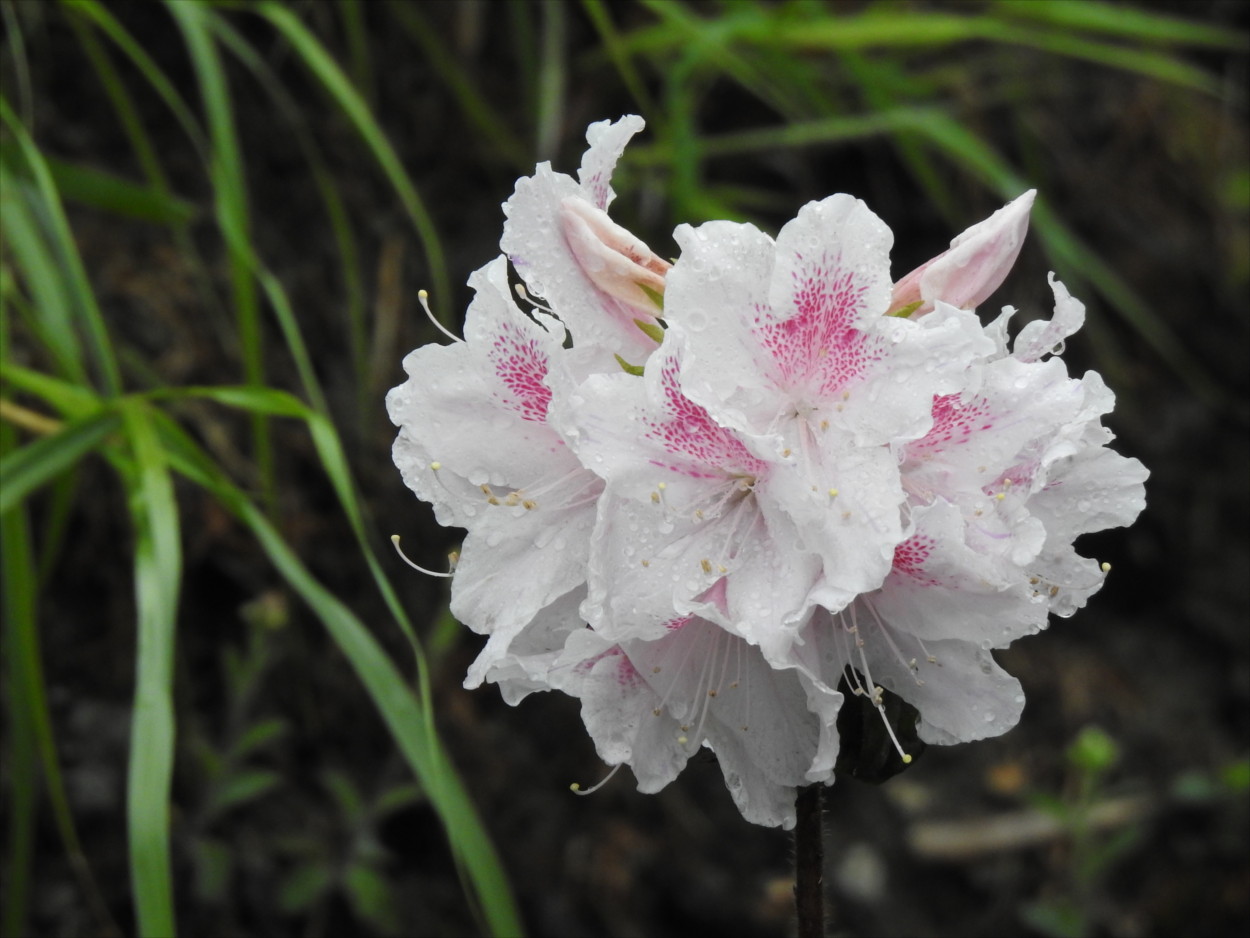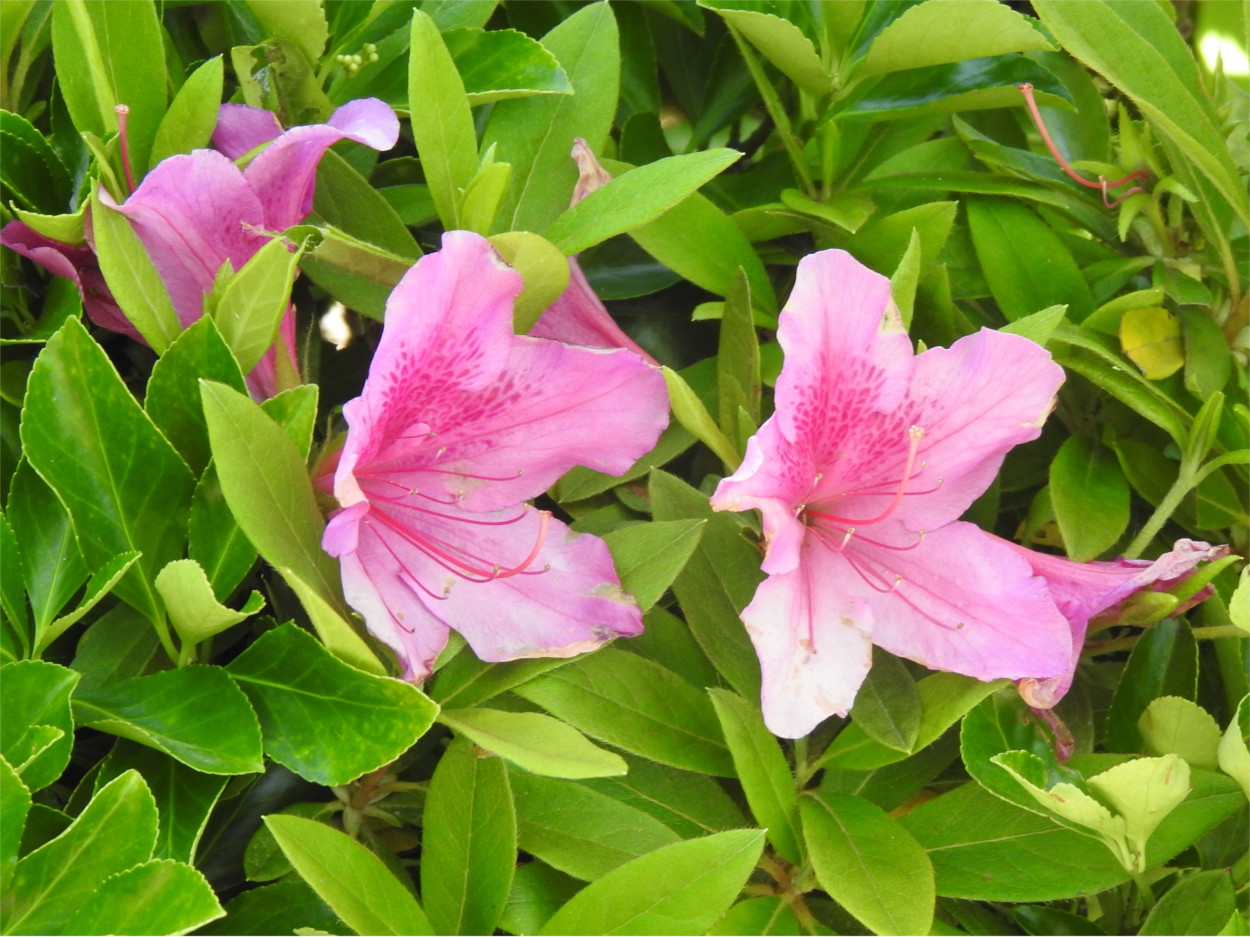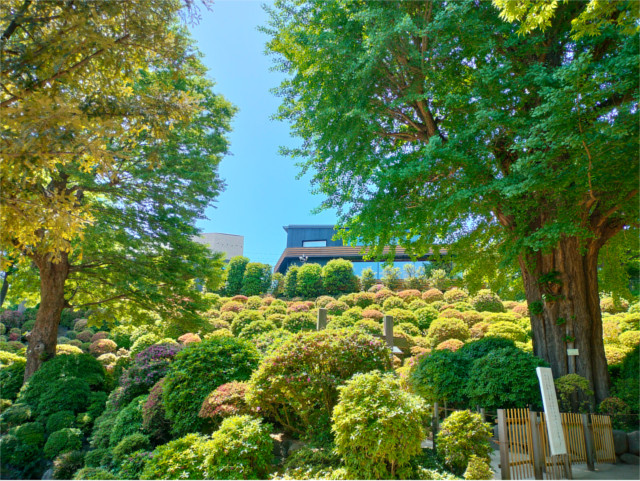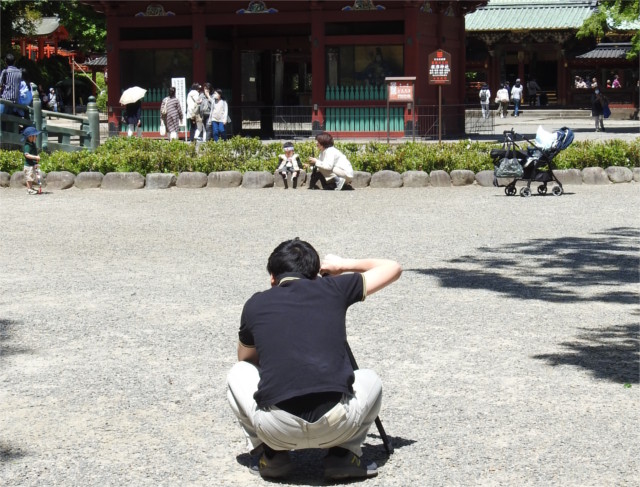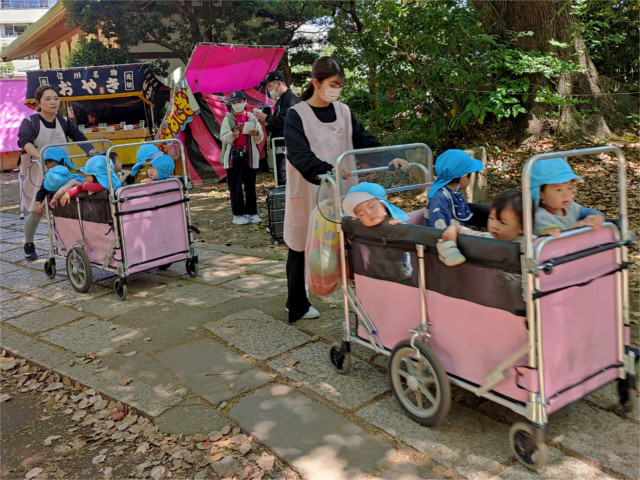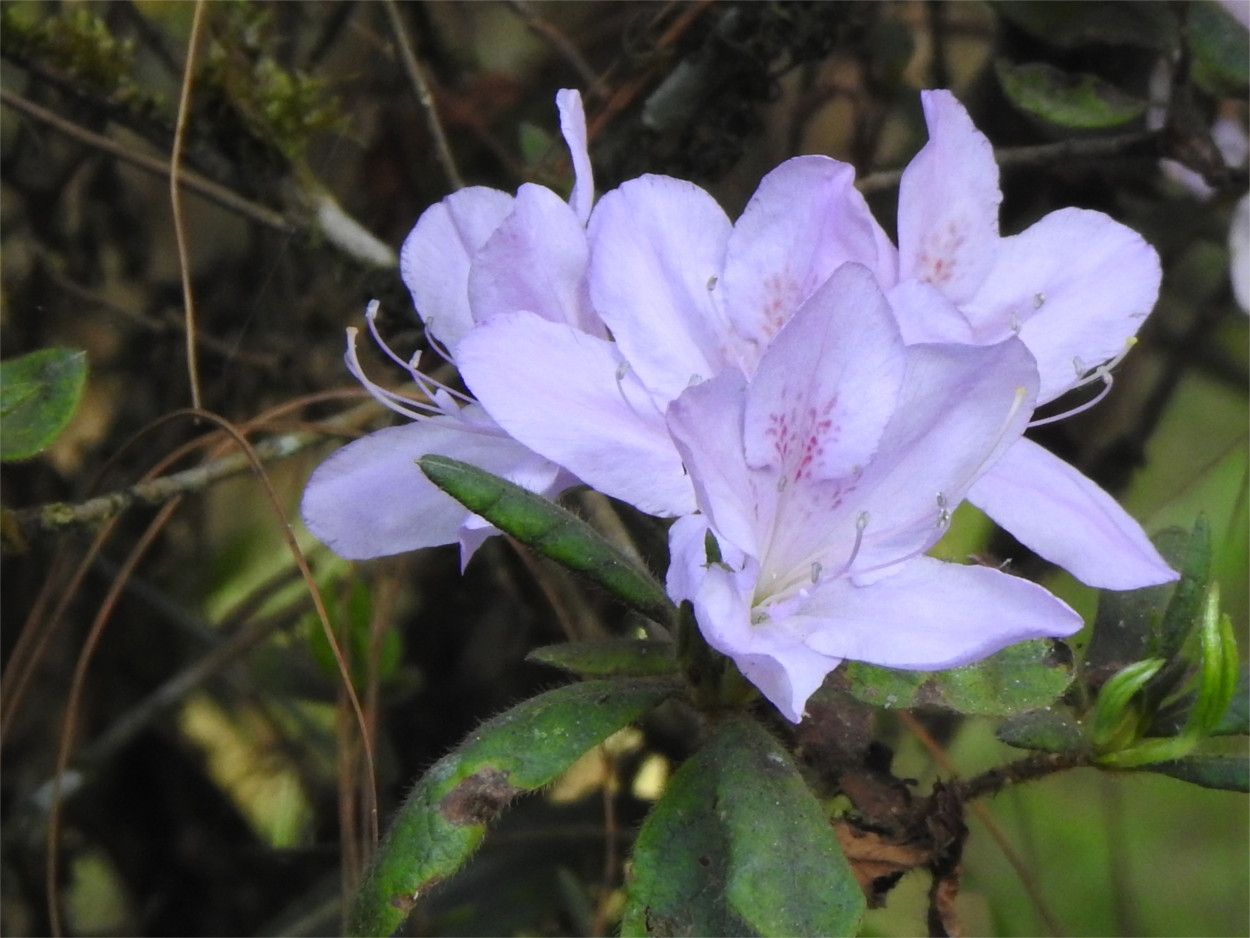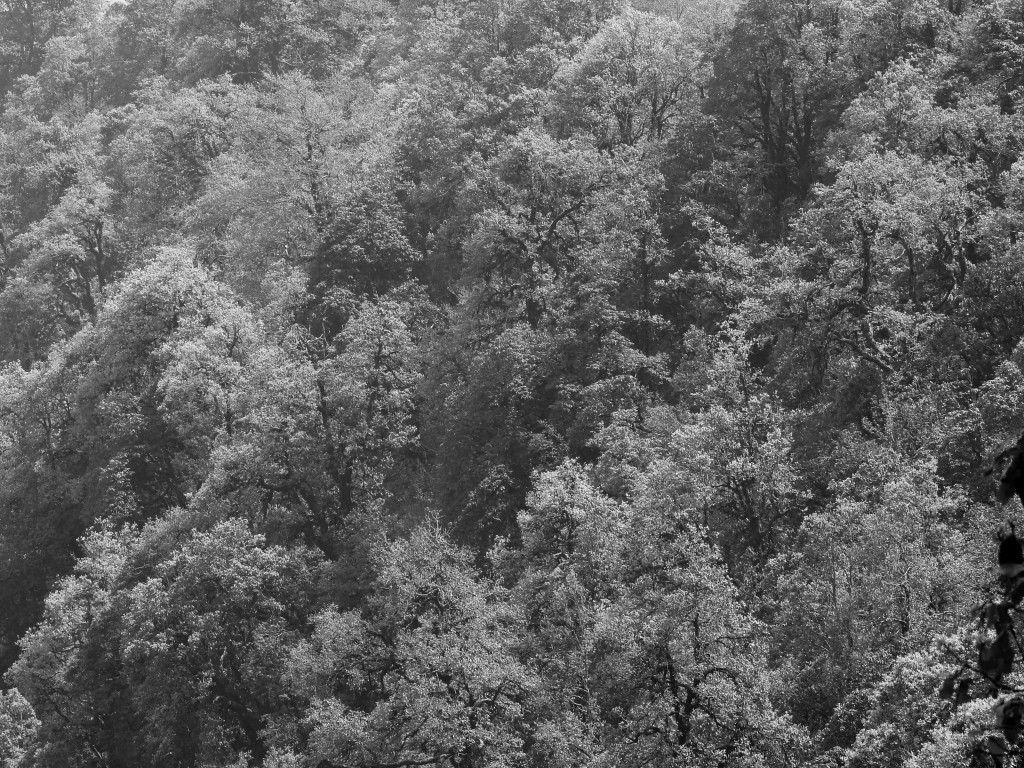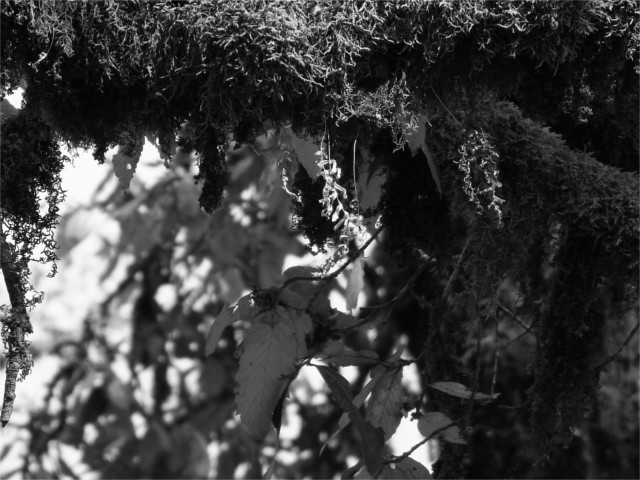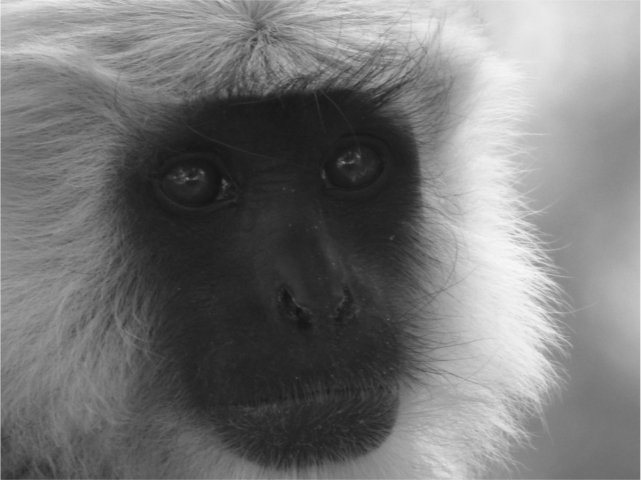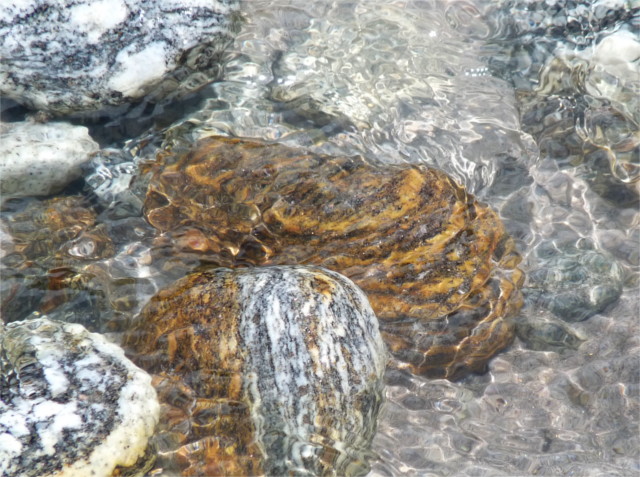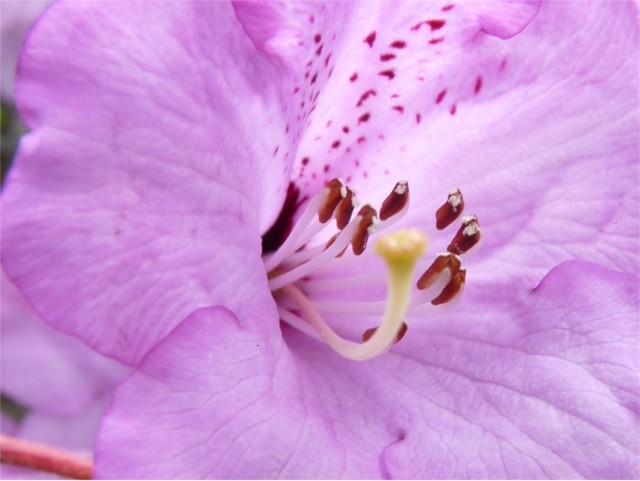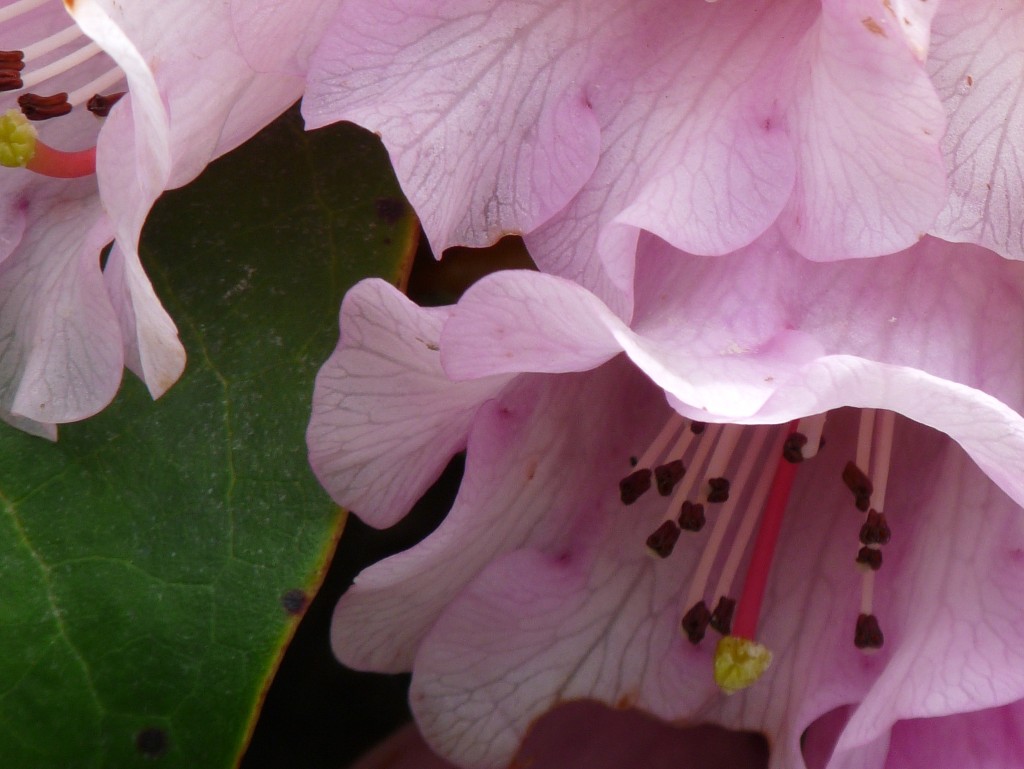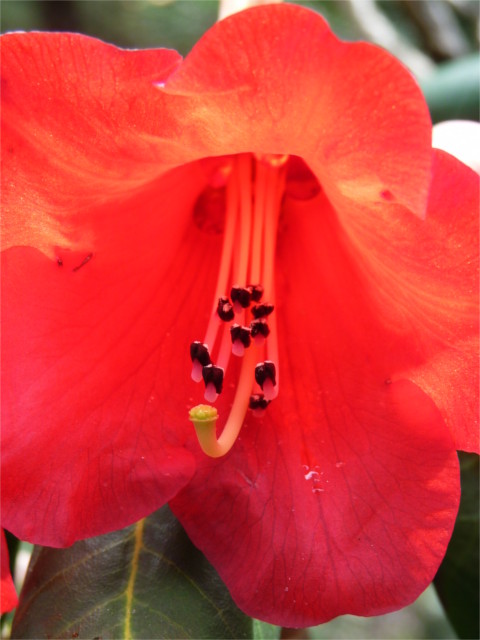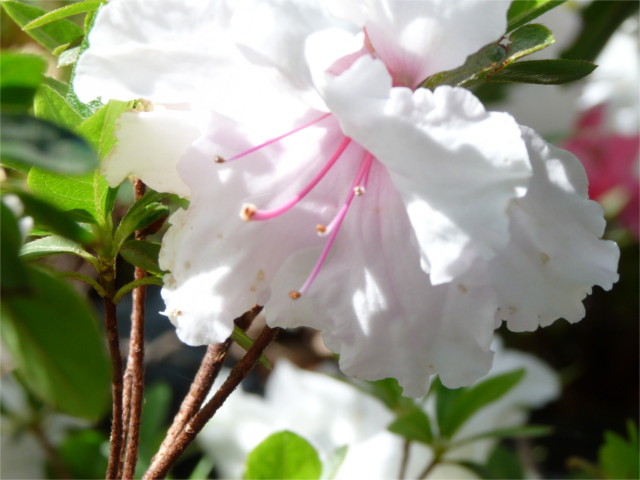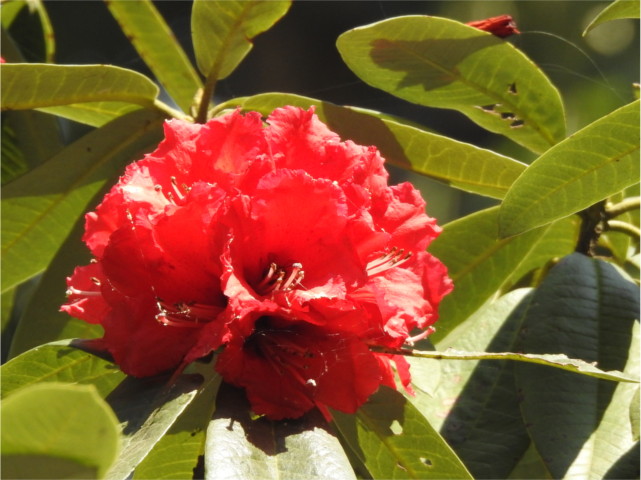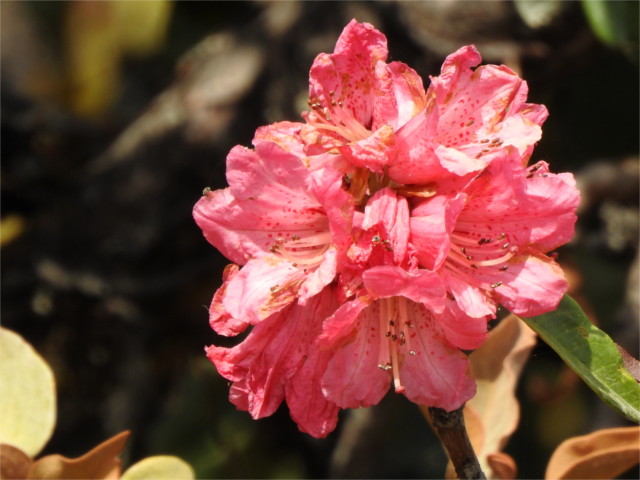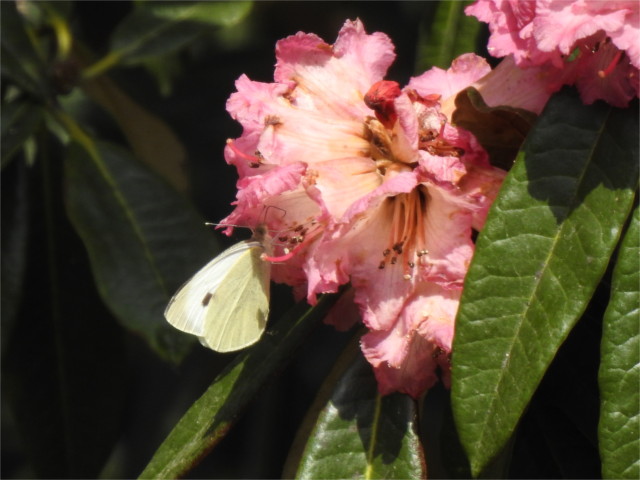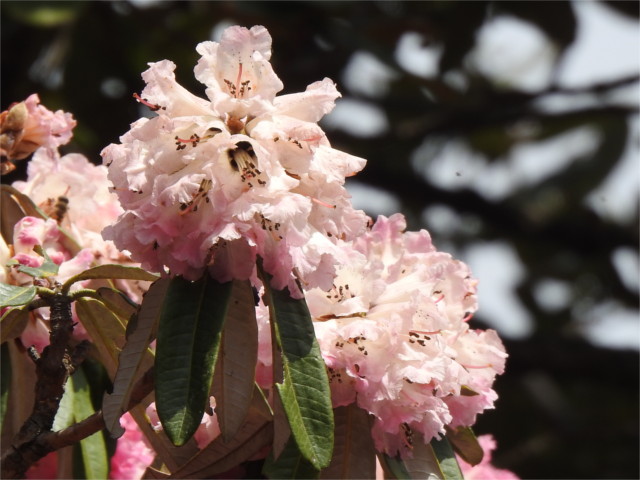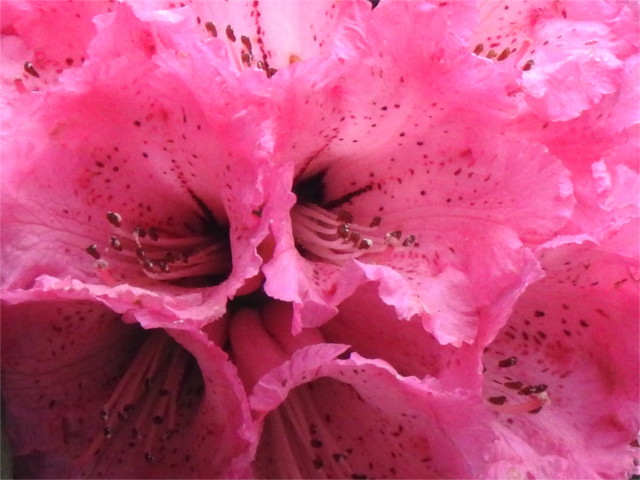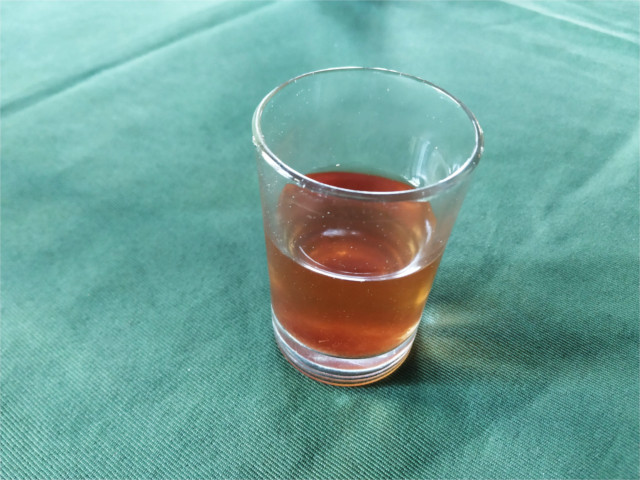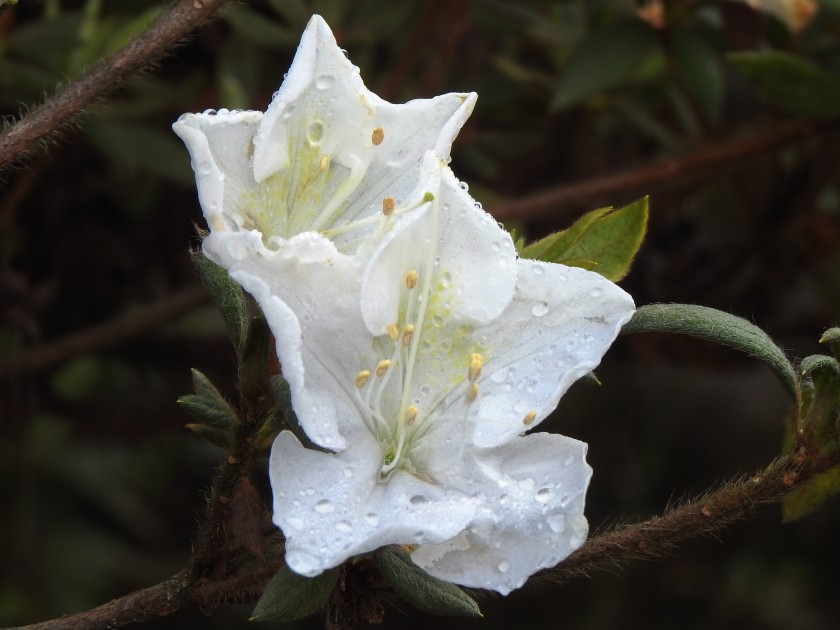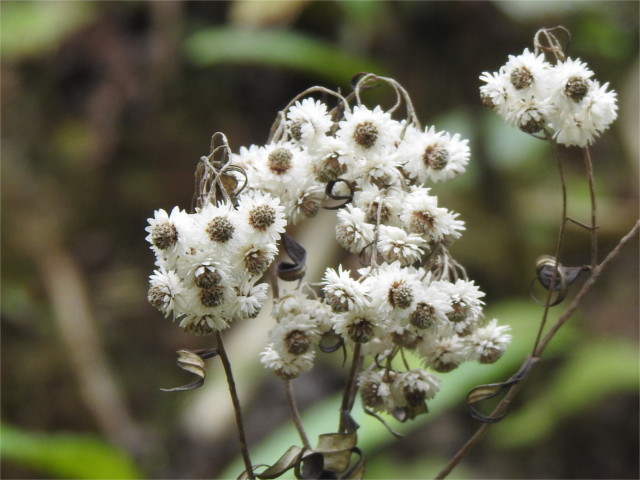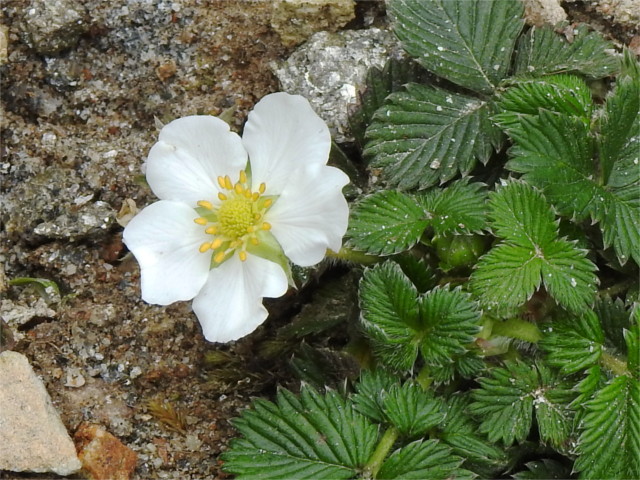Hybrid rhododendrons have found their way into gardens in regions from which the original rhododendron species were taken to England. This one resembles that old cultivar from 1896, Baroness Henry Schroeder. I think it’s only a resemblance, because that one has red splotches on the white base, but this is pink on white. It has been a warm winter in Sikkim, otherwise you wouldn’t see rhodos flowering now.
Tag: rhododendron
Tsutsuji matsuri
Azaleas are really something to celebrate, so the idea of a Shinto shrine in the middle of Tokyo which has an Azalea festival, the Tsutsuji matsuri, at the end of every April is fascinating. We got there two days after it ended, and caught the tail of the season. I’d spent two years planning a stay in Sikkim this April to watch the rhododendron bloom. It was a bit of a disappointment that I had to cancel that plan in order to visit Japan. But now I was seeing rhododendron flowers in any case: azaleas belong to the genus rhododendron.
Our first view of the Nezu shrine’s azalea garden (below) told us how narrowly we’d missed the peak season. A Japanese couple our age sensed our disappointment and led us to a poster with a calendar of the temples around Tokyo with dates when the azaleas were likely to bloom. An hour’s ride by the metro would take us to a place where they would bloom now. We thanked them and said we would take a walk around the shrine first.
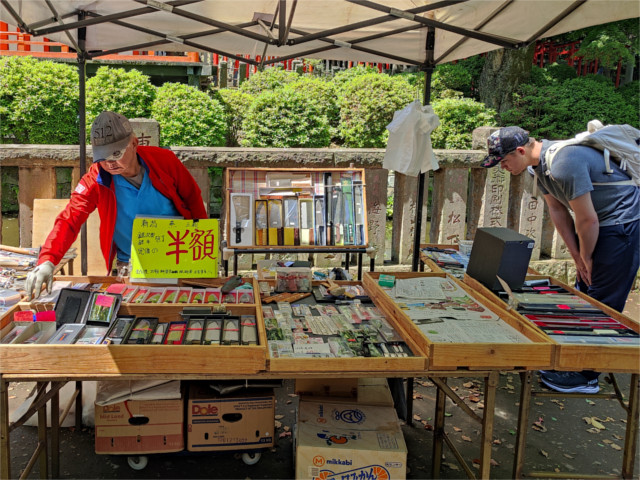

Temple festivals are large and colourful affairs, and if we’d arrived the previous week we would certainly have heard music and seen quite a bustle. Now just a couple of stalls remained. The Family examined the one with lots of home ware, and called me over to examine the kitchen knives. I was hovering around the shop selling dango. I love these glutinous balls made from rice flour, especially the smoky taste of mitarashi dango which are rolled in a mixture of soy sauce and molasses. A stick cost 500 yen, five times more than what I’d paid for a stick in Nikko the previous morning. That’s Tokyo for you!
The Nezu shrine is not on top of any tourist’s list. It certainly wasn’t on ours, but we were glad we came. It wasn’t very crowded, and most of the people who we saw were local. A family was busy taking photos of their younger son: the mother dressing the child as a samurai while the older brother played with some of the props and the father fussed with his camera.
When a place is used largely by the locals you see enigmatic sights. What was I to make of two trolleys full of toddlers being pushed along the path next to the shrine? Was this an outing from a day care? If it wasn’t the Saturday at the beginning of Golden Week, I would have embraced this idea. But on this long holiday, is that what it was?
Mad honey flower?
Mad honey is honey produced by bees which forage among Rhododendron. One has to be careful with the heather family of plants, Ericaceae. Although the family has everyday members like blueberries and cranberries, there are many relatives who are not above producing a little poison. These neurotoxins, the grayanotoxins, can make you very sick without killing you. But in low doses they are hallucinogenic. Mad honey, a small batch specialty from Nepal, contains nectar infused with grayanotxins from many species of rhodo. Interestingly, the buransh (R. arboreum with its dark red flowers) contains only very small quantities of these toxins. That’s why drinking the juice commonly available in Uttarakhand is neither toxic nor hallucinogenic. All this background did not help me to identify the rhodo flowers which I saw in a mild December in Darjeeling’s botanical garden.
Winter Rhodo
Winter in the mountains is the time of flowers on bushes in gardens. You don’t expect to see flowers on trees. Walking through Lloyd botanical garden, I was surprised by a small tree with purple flowers. I took several photos before I realized I was looking at a Rhododendron. It is not a genus which flowers so early in winter. Most species of rhodo flower in spring. So what was I looking at?
From the shape of flower and the leaves it may be the Bell rhododendron, Rhododendron campanulata. But since there are over a thousand known species of rhodo, I could be wrong. It turns out that I should have turned over the leaf and looked at its underside for better identification. You live and learn. Bell rhodo is normally a spring flowering species, so I’m puzzled by why it was flowering so early. Of course it was not really cold in early winter, but that must happen in many years. It could well be an exotic species. Isn’t that what you expect in a botanical garden? In the absence of a sign identifying it, this remains yet another abominable mystery.
A walk
You don’t get to do the same walk twice. So, although this is a walk I’ve written about earlier, I’m doing it again now in monochrome, and the featured photo is one example of this reworking. I’d posted a colour photo earlier. Although I like that more, I’m not unhappy with this version. It kind of fits the slowly fading memories I have of the walk. And there is also a sort of shadow, a memory of a memory of a memory of an earlier walk along the same route in colder weather.
This part of Binsar National Park is a mixed oak-rhodo-pine forest, in a dynamic dance with pine grasslands on other slopes. My understanding of their interactions has certainly improved since I last wrote about this walk. I should really go back now and correct my earlier post. Although these pine grasslands are much maligned by local ecology activists, there is increasing scientific evidence that the politics is based on early twentieth century understanding that may need to be revised. The mixed forests are not more bio-diverse, they are only more full of larger animals. Slopes full of pines are very photogenic. Experimenting with monochrome, I found that long shots of these mixed forests are also turn out well. The white undersides of the leaves of Himalayan white oak (Quercus leucotrichophora) reflect light very well when a breeze moves them.
I’d stopped many times to take photos of the butterflies sunning themselves on the path. Fallen oak leaves spotted with mould in the dappled light which filtered through the canopy presented an interesting challenge in monochrome conversion. I like the way the butterfly appears slowly as you look at the photo above. This is the mountain tortoiseshell (Aglais urticae), which is easier to recognize in a colour photo I’d posted before.
Oak trees support a lot of other plants and fungi which feed on them. These ferns, mistletoe, orchids, and lichens and fungi catch light in different ways. As a result, oaks are great subjects for close up photos. I love them in colour, but I’m not unhappy with the wide variety of shadows I see in the photo of above. I think I’ll have to keep that in mind for the future. I’m sure there are wonderful opportunities for more monochrome photos lurking in these forests.
I can’t leave this place without saying something about the mammals which live here. I never managed to photograph the quick yellow-throated martens which run through these jungles, but the band of Nepal gray langur (Semnopithecus schistaceus) which I saw here waited long enough for me to take photos. I’ve posted a colour photo of the individual you see here earlier. I think she looks equally elegant in monochrome.
A lovely spot
We stayed the night in a homestay in Lachung village. The village is named after the river it is on. In the morning we followed the river to Yumthang valley. We were on a trip to Sikkim, eleven years and eleven days ago. The road took us through a rhododendron sanctuary. I remember colours of rhododendron that I have not seen elsewhere. Purples, light reds, greenish yellow, and funereal white. It is an amazing sight, and one that I was planning to take my niece to see at the beginning of this month. Unfortunate that the country was locked down, and she was infected (she recovered very quickly). It will be another year before we can try to take that trip again.
The road continues to the open valley bordered by high mountains. It was cloudy, and extremely windy. Through the clouds we could see glaciers coming down the slopes of the surrounding mountains. Some people had camped there. I dipped a hand into the river. Cold. I was happy with a night in Lachung. There were trout in a holding pond. You are allowed to fish in the river. Was the trout supposed to be released back into the water?
It was a great place for photos. I wandered around taking in the primula, the irises, the glaciers. There were even butterflies; I got a photo of the Indian Tortoiseshell (Aglais caschmirensis). It was a lovely place, but by late morning I had a feeling that a spot of tea would come in handy. That’s one thing this place did not have. I wished I had thought of carrying a thermos full of tea up here.

They let the Zebra and the Giraffe get up; and Zebra moved away to some little thorn-bushes where the sunlight fell all stripy, and Giraffe moved off to some tallish trees where the shadows fell all blotchy.
‘Now watch,’ said the Zebra and the Giraffe. ‘This is the way it’s done. One—two—three! And where’s your breakfast?’
Leopard stared, and Ethiopian stared, but all they could see were stripy shadows and blotched shadows in the forest, but never a sign of Zebra and Giraffe. They had just walked off and hidden themselves in the shadowy forest.
Rudyard Kipling, in “How the Leopard got His Spots”, Just So Stories
Dotted and striped patterns arise repeatedly in nature: butterflies, flowers, fish, big cats. Kipling’s story seems to be verified by biologists. But what is the genesis of such patterns? In 1952 Alan M. Turing made an observation that people have built on since then. He wrote: “It is suggested that a system of chemical substances, called morphogens, reacting together and diffusing through a tissue, is adequate to account for the main phenomena of morphogenesis. Such a system, although it may originally be quite homogeneous, may later develop a pattern or structure due to an instability of the homogeneous equilibrium, which is triggered off by random disturbances.” The featured photo of the river in Yumthang explains what Turing meant. Imagine a tub of perfectly still water. Sunlight falling on it would illuminate the bottom of the uniformly. Now take the random winds that disturb water in a river, and the random placing of obstructions below. The net effect is a series of interlocking ripples which refract the water and give that dotted pattern of shadows on river bottom. Turing realized that patterns in nature could arise in the same way, due to the flow of pigments being disturbed during the early development of the organism. Subsequent authors have studied and begun to understand how these patterns are formed by the actions of genes, and how they are inherited.
Changes
Flowering of the Rhododendron arboreum, the tree Rhododendron, is said to be extremely temperature sensitive. My own experience also verifies this. Four years ago I found that the second week of March was too early for flowers at Barsey Rhododendron Sanctuary (altitude 2500 m) in Sikkim. But when I was in Yuksom (altitude 1780 m) the previous day, the red Rhododendron had been in full bloom. I verified it this year again. At Kolakham (altitude 1980 m) in the Kalimpong district of West Bengal I could see Rhododendron buds in early March, but in Latpanchar (altitude 1500 m) they were already in full bloom when I went there the next day. When we reached our hotel outside Almora (altitude 1604 m) in early April, there was only one blossom left among all the trees on the grounds. But twenty kilometers away, just inside Binsar National Park, at an altitude of about 2200 m, hillsides were dotted with the red of flowering Rhododendron. These mountain roads are extremely slow, and you may take an hour to travel thirty kilometers. So when we plan trips to view Rhododendron flowers, we focus carefully on details like this.
Altitude causes another strange change. Over most of its range R. arboreum has deep red flowers, sometimes deeper than the red of blood and wine. But as you climb to over 2500 meters in altitude, the same species will produce flowers which can be any shade of pink, and even white. The red flower in the slide show here comes from Binsar National Park, from an altitude of perhaps about 2200 meters. The rest come from the highest point of the road above Munsiyari, perhaps at an altitude of just under 3000 meters. I don’t have words for the variety of pinks that you can see.
It pays off to look closely at the flowers with these lighter colours. Unlike their dark red siblings, they show characteristic spots and stippling. On my first trip to Sikkim I’d been entranced by these details on flowers I had seen in Yumthang valley (altitude 3500 m) late in the season, in early May. Are these a different subspecies? There is a recognized subspecies called the Rhododendron arboreum cinnamomeum, but this is easily identified by the bright cinnamon colour of the underside of the leaf. These variant plants were not of that subspecies. The colour changes were not due to soil conditions, either, since you could see differently coloured flowers on trees in the same slope, sometimes growing so close that their canopies touch. Each tree had flowers of a single colour. Someone would have to do more field work to check whether the colour remains the same from one year to the next, and whether it changes if the seed of a tree is planted at a lower altitude. It is quite possible that this has been studied in the last three hundred years, and a better scholar than me will able to dig out the details.
Drinking rhododendron
The western Himalayas have the wonderful drink called Buransh. In Kumaon this would translate to Rhododendron. Interestingly, the plant has different names in other regions of the western Himalayas (for example, in Himachal the local name for the plant is Bras), whereas the name of the drink is the same. This probably means that the origin of the drink is Kumaoni, and it has recently spread across the mountains. The Family usually buys bottled Buransh from village cooperatives when we travel in the mountains.
The recipe is terribly simple. Take a kilo of the petals. Carefully separate them from the rest of the flower; the nectar is poisonous, and causes your blood pressure to fall, sending you into shock. The locals throw away the stigma and anthers too, and wash the petals thoroughly. So I assume that the pollen is also dangerous. Perhaps it is best not to make it at home until you learn from a Kumaoni family what to do. When I was trying to figure out this recipe, I was reminded of certain mushrooms you see in markets in Finland and Sweden. The vendors refuse to sell it to people who speak English. This is not xenophobia, but a safety measure. The mushrooms are poisonous unless you know exactly how to cook them. Using Rhododendron in the kitchen is similar to cooking these mushrooms: if you know what to do it is safe, otherwise it can be very dangerous.
So, back to the recipe. Take a kilo of the petals. Clean them thoroughly. Put them in about two liters of water. Bring this to a boil, and leave it simmering for about thirty minutes. Strain through a fine mesh, crushing the pulp to extract the flavour. Mix sugar to taste in the warm water. About three quarters of a kilo of sugar is usually needed for every kilo of petals. The juice is ready. If you preserve this in a fridge it might last two to three days. The shelf life can be extended by adding citric acid. If you add this, choose the amount judiciously, otherwise you can overwhelm the delicate flavour of the flower.
Rhododendron heights
This is meant to be extremely literal: red rhododendron (Rhododendron arboreum) in its native Himalayas grows at altitudes between 1500 and 2500 meters. This means that almost all of Kumaon is at the right altitude for this lovely blood red flower. Micro-climates can cause upward or downward fluctuations in this band. Human effort also brings it down to gardens at somewhat lower altitudes in India, but not to the plains. Climate change can also cause upward migration of the tree, but as as tourist you would not be able to disentangle the effect of micro-climate and global warming.
After several years, we’d come back to a hotel outside Almora which has a large area of jungle around it. We woke late, did a little birdwatching right from the balcony of our room. When we walked down for breakfast I was surprised to find no flowers on the rhododendron. Just a month before we’d been to a similar height and the rhodos had not started flowering. Early April is smack in the middle of the season. “Monkeys,” explained the person we asked. “They come and eat the flowers.” I found one flower which they had missed. That’s the one you see in the featured photo.
Himalayan wildflowers
Our senses are poor servants. Even colour sense, which is the most acute as it is the most important for our purpose, is weak. We have, it is true, definite names for many colours, but how many of us recognize them when we see them? But our colour names are few in comparison with the number of shades we wish to distinguish, and that is the measure of our vagueness. … Thus, we do not match flower colour, we merely indicate its quality; only haberdashers match colours.
Smells are even more indefinite. Some are indistinguishable from tastes, or the two are so involved that it is difficult to say where one ends and the other begins. But there are only five primary tastes- sweet, bitter, saline, acid and pungent- not one of which can be confused with any smell; it is only when we come to deal with flavours that, again resorting to analogy, we get into difficulties. … In fact, we can do little with smells except classify them as ‘good’ and ‘bad’ or ‘aromatic’ and ‘foetid’.
It is this capital difficulty which prevents people from attempting to say much about scent in flowers and leaves.
I quote from Frank Kingdon Ward’s book, The Riddle of Tsangspo Gorges
